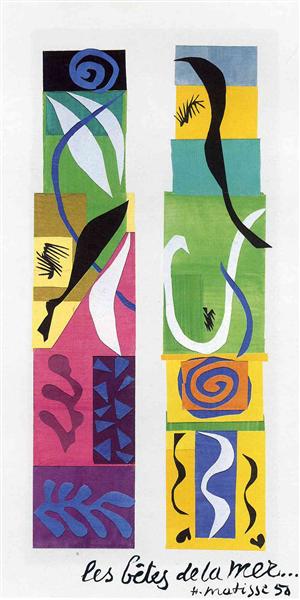Description
The work "The Maritime Wildlife" by Henri Matisse, dated 1950, is part of the set of pieces that certify the skill and versatility of the French artist in the use of color and form. Measuring 30x60 cm, Matisse presents us with a vibrant and dynamic maritime panorama that encapsulates his creative genius and unparalleled ability to condense the essence of life into masterful shapes and tones.
Henri Matisse, one of the founders of Fauvism, was a pioneer in liberating color and form from realism. In "The Maritime Wildlife," we see how these innovations are masterfully deployed. The work confronts us with a vibrant composition where marine fauna comes to life through cut-out shapes and bold chromaticism. Warm tones of yellow and orange predominate, contrasting with deep blues and greens, evoking the sea and the richness of underwater vegetation. This chromatic audacity, characteristic of Fauvism, allows Matisse to emphasize the vitality and dynamism of the scene without resorting to a faithful representation of reality.
The composition stands out for its apparent simplicity, which, however, hides a deep understanding of spatial structuring. The figures of marine animals, although stylized and almost abstract, are perfectly recognizable; the fish stand out as they seem to float in a sea of leaves and algae, without a clear notion of depth or traditional perspective. This bidimensionality is intentional and highlights Matisse's desire to break with conventions and create a visual experience where the viewer immerses themselves in a universe where form and color dominate over realistic representation.
A fascinating element of "The Maritime Wildlife" is the technique of painted paper cut-outs, which Matisse extensively used in his last decades of life due to health problems that prevented him from painting in the traditional manner. This technique, which he dubbed "drawing with scissors," allowed him to continue exploring color and form with renewed freedom and, at times, with greater immediacy. The cut-outs that make up the marine fauna and flora are a testament to this phase of his career, where his creativity reached new dimensions despite physical limitations.
The impact of works like "The Maritime Wildlife" lies not only in their immense aesthetic value but also in their ability to influence subsequent generations of artists and designers. The use of pure color and the experimentation with abstract forms and mixed techniques remain an indisputable source of inspiration in the history of modern art.
In conclusion, "The Maritime Wildlife" is not simply a representation of marine life but a brilliant synthesis of the spirit of experimentation and the search for new forms of expression that characterize Henri Matisse's work. It is a piece that, each time it is observed, reveals new layers of meaning and demonstrates the perennial ingenuity of one of the greatest masters of modernity. In this work, the combination of vibrant chromaticism with innovative technical execution comes together to offer us a visual experience that is as fresh and relevant today as it was at the time of its creation.

